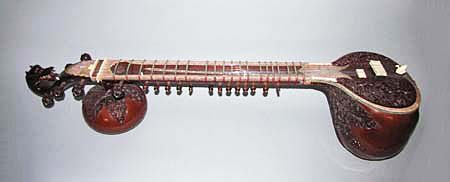
Owner: HWMC
Catalog#: AS-CHLT-07-14
Provenance: Alan Suits of Coyote’s Paw Gallery
Lutes
India ‘Surbahar’ (Bass Sitar)
India
Hindustani Speaking People
Mahongany wood (Cedrela toona), gourd, metal string, ebony, deer horn
Mid 20th century
Length: 52 in
Chordophones – Lutes
The surbahar developed during the early years of the 19th century and started making its appearance on the Indian classical music scene around 1825. It is often described as the “bass sitar” in that it is bigger than a sitar, yet produces a sound closer to the ancient bin (veena). As recently as the early years of the 20th century, it was commonplace for musicians to carry both sitar and surbahar to play. They would begin with the “alap” section (introduction) playing the surbahar, then switch over to the sitar during the “gat” and “improvised” sections.
This surbahar was made by Sarat Sardar, a noted sitar maker in Calcutta, who was known for his design and quality of carving. The upper resonator is singular in its use of stave-construction (similar to a barrel or a lute back). All the pegs are custom crafted, unlike most sitars, which have mass-produced pegs. The neck has very wide moveable frets, which allow a glissando of six notes on the same fret through the method of pulling. A distinctive feature of this example is that the neck terminates in a carved dragon head. The body and resonator at the end of the neck is formed from large gourds with ornate carved and inlaid wooden covers.
